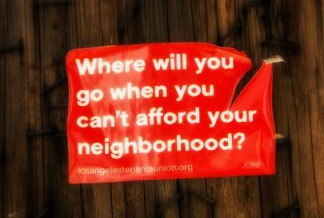
Image credit: Ted Soqui / Portside.org
As the American economy becomes increasingly concentrated in a handful of large metropolitan areas, housing has become an ever-pressing issue as longtime residents and new arrivals compete for housing stock that in many cities has not kept up with population growth and demand. While this phenomenon is seen in cities across the country from Austin to Boston and New York to Seattle, nowhere has the housing crisis become more dire than the state of California.
With the number of people leaving California for more affordable areas like Texas, Colorado, and the Pacific Northwest, you’d think that housing affordability would balance itself out. In fact, it’s quite the opposite; while California has the largest exodus of low-income and non-college educated adults in the country, it is the 2nd most popular destination for recent college graduates. [1] This influx of higher-income college graduates coupled with the lack of housing construction in major cities across the country has caused them to seek housing in low-income communities where their relative affluence alters the socioeconomic fabric of the community and begins the process of gentrification. [2]
Which brings us to the vendetta here: change v. continuity. That is, can cities address the affordability crisis while simultaneously preventing displacement and preserving neighborhood character? Or, must one be sacrificed?
Lining the vendetta are three main advocacy buckets:
NIMBYs (Not In My BackYard) – not an actual group but rather a social phenomenon in which neighborhoods fight development in order to preserve community interests like neighborhood character and property values.
Anti-gentrification groups – largely local with national networks that prioritize low-income current residents in housing policy in order to prevent their displacement in the face of more affluent new arrivals.
YIMBYs (Yes In My BackYard) – largely local groups within a national network that prioritize the construction of new, mostly market-rate, housing stock as a long-term solution to affordability.
While proposed solutions to the affordability crisis are everywhere, it helps to understand the source of the problem. Since the 1960s cities like Los Angeles have ceded control over land use planning to neighborhood groups dominated by homeowners who are largely white and affluent. These groups drastically reduced the permissible housing stock across cities by lowering density, widening minimum lot sizes, and shuttering development through advocacy at city council, ballot initiatives, and litigation. In LA this has resulted in the city going from a zoning capacity of 10 million in 1960 to 4.2 in 2015 [3]; by 2016 its population reached 3.9. [4] As a region, metropolitan Los Angeles is home to more than 10 million [5], yet its rental vacancy rate in 2015 was 2.7% [6]. What that means is only 2.7% of rentable units were available for rent in the last quarter of 2015 (by contrast, the national rental vacancy rate at the time was 7%.)
So if NIMBYist neighborhoods have shut off local development and pushed new arrivals to low-income neighborhoods causing displacement, what are the proposed solutions? As a group opposed to development in their “backyard”, it is no surprise that NIMBY groups offer few solutions to the affordability crisis. In any case, being concerned with maintaining local character and property values, these groups are often content to allow development elsewhere so long as it won’t affect them. In another bucket, anti-gentrification groups who aim to prevent displacement in low-income communities have fought for increasing affordable housing mandates in market-rate units, expanded rent control, and giving more voice to current residents on new developments. [7] Some more radical groups advocate for taking the market out of housing policy. [8] In the final bucket are YIMBYs whose policy positions prioritize the construction of new housing, everywhere: rich communities, poor communities, and everywhere in-between. They prefer market-rate housing, which the overwhelming majority of renters end up renting.
If you’ve read the title, it’s quite clear where I come down on this issue. While I agree with many anti-gentrification activists that wealthy home-owning NIMBYs have exacerbated the problem, I fail to see how a solution that largely addresses the needs of low-income current residents will reduce pressure on higher-income new arrivals looking for housing who are priced out of wealthy neighborhoods but don’t qualify for traditional affordable housing programs. In many cases, anti-gentrification groups oppose the construction of market-rate housing under the impression that it will induce demand for that neighborhood and begin gentrification. [8] Compounding this are demands that significant percentages of new developments must be set aside at below-market rates. Requirements of 25% below market-rate housing passed as a ballot initiative in San Francisco, and this has cratered the number of proposals for new housing resulting in the city seeing fewer new large housing starts and even fewer affordable housing units than trends suggested prior to the passage of the requirement. [9]
My views align with YIMBY groups that advocate for housing construction everywhere. While many claim that by expanding market-rate housing YIMBY policies accelerate gentrification by inducing demand from higher income earners that eventually price out the larger community, the claim is misguided. In fact, in parts of cities that have undergone major increases in housing, like downtown Los Angeles, local rents at a minimum have slowed their rate of increase and in some cases have stabilized or even gone down. [10] If other urban neighborhoods were to undergo a similar housing boom, even at the higher end, wealthier home-seekers wouldn’t have to compete for the same housing as low-income residents. To pursue that goal, YIMBY-aligned state Senator Scott Weiner (D-CA) proposed a bill that would encourage increased density within .25 – .5 miles of a major transit stop. SB 827 would mandate that areas within .5 miles of a rail transit stop be allowed to develop multifamily housing at least 45-85 feet high depending on local conditions. [11] One of the other benefits of this bill would be to encourage mass transit use and decrease the number of people who commute to work in personal vehicles.
While the bill died in committee on 17 April 2018, to me it serves as model legislation in that it keeps individual neighborhoods from throwing a wrench into city-wide housing needs because of their interests. With the defeat of this bill, the housing crisis will only get worse until these three competing groups manage to find common ground somewhere and propose a comprehensive solution.
Take Action
While much of my article contained policy and data for Los Angeles, San Francisco, and the state of California, these same problems play out nationwide. For those who prioritize preventing gentrification/displacement, you can have your voice heard as part of the many Democratic Socialists of America (DSA) chapters in cities across the country or in other tenants rights and anti-gentrification organizations. Unfortunately, for those who, like me, prioritize the construction of new housing, there are fewer organized YIMBY groups nationally, however that also opens the door for you to start a group yourself and get involved in your local government’s planning meetings.
References
- Johnson, H. (2017, June 21). California is Still Golden for College Graduates. Retrieved April 18, 2018, from http://www.ppic.org/blog/california-still-golden-college-graduates/
- Poitras, L., & Bryant, L. G. (2003, January 17). What is Gentrification? Retrieved April 18, 2018, from http://www.pbs.org/pov/flagwars/what-is-gentrification/
- Grabar, H. (2015, April 06). The incredible shrinking megacity: How Los Angeles engineered a housing crisis. Retrieved April 18, 2018, from https://www.salon.com/2015/04/05/the_incredible_shrinking_megacity_how_los_angeles_enginereed_a_housing_crisis/
- LA City. (2017, August 1). Retrieved April 17, 2018, from https://www.census.gov/quickfacts/fact/table/losangelescitycalifornia/PST045216
- LA & Orange County. (2017, August 1). Retrieved April 17, 2018, from https://www.census.gov/quickfacts/fact/table/orangecountycalifornia,losangelescountycalifornia/PST045216
- Southern California Public Radio. (2016, April 12). LA’s rental market tightens; vacancy rate falls to 2.7 percent. Retrieved April 18, 2018, from https://www.scpr.org/news/2016/01/28/57103/la-apartments-rental-vacancy-rate-fall-to-27/
- Tenants Together. (2018, March). Repeal the Costa Hawkins Rental Housing Act. Retrieved April 18, 2018, from http://www.tenantstogether.org/campaigns/repeal-costa-hawkins-rental-housing-act
- DSA Los Angeles. (2017, October 05). Housing & Homelessness Committee Platform. Retrieved April 18, 2018, from http://www.dsa-la.org/housing_homelessness_committee_platform
- Local Politics. (2017, June 12). The 25% inclusionary rate is killing affordable housing. Retrieved April 18, 2018, from https://medium.com/yes-in-my-blog-yes/the-25-inclusionary-rate-is-killing-affordable-housing-db143c4abd31
- Romero, D. (2017, November 18). A Sign of Hope: “Stagnant” Rents in Once-Hot DTLA. Retrieved April 18, 2018, from http://www.laweekly.com/news/as-new-units-open-rents-begin-to-stabilize-in-downtown-los-angeles-8695036
- Roberts, D. (2018, February 23). The future of housing policy is being decided in California. Retrieved April 18, 2018, from https://www.vox.com/cities-and-urbanism/2018/2/23/17011154/sb827-california-housing-crisis



